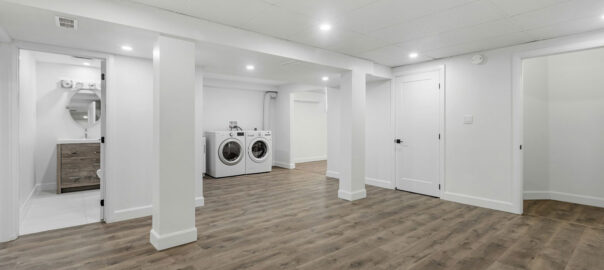Basements have transcended their traditional role as mere storage spaces, evolving into versatile extensions of our homes, accommodating various functions such as entertainment areas, home offices, gyms, and more.
With this evolution, the demand for durable, stylish, and practical flooring solutions capable of withstanding the unique challenges of basement environments has surged.
In this comprehensive guide, we’ll delve into the latest basement flooring options, providing insights into their features, benefits, and suitability for different needs and preferences.
Subflooring and Underlayments
Before diving into the myriad basement flooring options, it’s crucial to lay a solid foundation to ensure durability, stability, and protection against moisture.
Subflooring and underlayments play vital roles in providing support, insulation, and moisture resistance for the chosen flooring material. Here’s a brief overview of commonly used subflooring and underlayment options:
1. Subflooring
- Plywood Subfloors: Known for their strength, stability, and resistance to moisture, plywood subfloors serve as a reliable foundation for various types of flooring.
- Oriented Strand Board (OSB): Engineered for durability and dimensional stability, OSB subfloors offer an alternative to plywood, suitable for basement environments.
- Concrete Subfloors: In some cases, the existing concrete slab may function as the subfloor, requiring appropriate leveling, sealing, or waterproofing for optimal flooring installations.
2. Underlayments
- Foam Underlayments: Lightweight and easy to install, foam underlayments provide cushioning, sound absorption, and moisture management properties for basement floors.
- Cork Underlayments: Renowned for their natural resilience and thermal insulation properties, cork underlayments offer sustainable options for enhancing comfort and performance.
Exploring The Latest Basement Flooring Options
1. Luxury Vinyl Plank (LVP) Flooring
Luxury vinyl plank flooring has emerged as a popular choice for basement renovations due to its blend of aesthetics, durability, and affordability.
Designed to mimic the look and feel of natural wood or stone, LVP flooring creates a warm and inviting ambiance. Its waterproof properties and resilient construction make it highly resistant to moisture, making it ideal for humid basements prone to occasional water intrusion.
Moreover, its easy installation and low maintenance requirements make it a practical solution for busy homeowners.
2. Engineered Hardwood Flooring
Engineered hardwood flooring offers the timeless beauty of hardwood with enhanced durability, making it suitable for basement environments.
Comprising multiple layers of wood veneer bonded together, engineered hardwood is more resistant to moisture and temperature fluctuations compared to solid hardwood.
With a wide range of finishes, textures, and wood species available, homeowners can achieve their desired aesthetic while enjoying the benefits of engineered wood.
3. Porcelain Tile Flooring
Porcelain tile flooring is renowned for its durability, versatility, and aesthetic appeal, making it an excellent choice for basements.
With advanced manufacturing technologies, porcelain tiles can replicate the look of natural stone, concrete, wood, or marble while offering waterproof and stain-resistant properties.
Ideal for high-traffic areas, porcelain tile flooring is easy to clean and maintain, making it suitable for basements used for various purposes.
4. Waterproof Laminate Flooring
Waterproof laminate flooring combines the beauty of hardwood or stone with the durability and moisture resistance of laminate, making it an ideal choice for basements.
Featuring a rigid core construction and a waterproof backing layer, waterproof laminate flooring effectively repels moisture and prevents water damage.
Available in various finishes and plank sizes, it offers versatility and customization options to suit different basement aesthetics.
5. Epoxy Flooring
Epoxy flooring is a versatile and durable option for basement floors, offering excellent resistance to moisture, stains, chemicals, and abrasion.
With its seamless and easy-to-clean surface, epoxy flooring is ideal for basements used as workshops, home gyms, or recreational areas. Available in a wide range of colors, patterns, and finishes, epoxy flooring allows for customization to match the homeowner’s preferences and style.
6. Cork Flooring
Cork flooring is gaining popularity as a sustainable and eco-friendly option for basement floors. Harvested from the bark of cork oak trees, cork flooring is naturally resistant to moisture, mold, and mildew, making it ideal for damp basement environments.
Additionally, cork flooring provides excellent thermal and acoustic insulation, enhancing comfort and reducing noise transmission between floors.
7. Rubber Flooring
Rubber flooring offers durability, shock absorption, and slip resistance, making it suitable for basement floors subjected to high impact and foot traffic.
Made from recycled rubber materials, it’s an environmentally friendly option for homeowners. Available in tiles or rolls, rubber flooring is easy to install and maintain, providing a comfortable and safe flooring solution for various basement activities.
8. Stained Concrete Flooring
Stained concrete flooring offers a modern and sleek aesthetic for basement spaces. With its durability and resistance to moisture, stains, and scratches, stained concrete flooring is well-suited for high-traffic areas.
Various staining techniques and finishes allow homeowners to customize their basement floors to achieve a unique look.
9. Carpet Tiles
Carpet tiles offer warmth, comfort, and design flexibility for basement floors. Available in a variety of colors, patterns, and textures, carpet tiles allow for creative design configurations.
Unlike traditional broadloom carpeting, carpet tiles are easy to install and replace, making them ideal for DIY projects or basement renovations.
10. Engineered Bamboo Flooring
Engineered bamboo flooring provides a sustainable and durable option for basement floors. Made from layers of bamboo fibers bonded together, engineered bamboo flooring offers natural beauty and resilience.
With its eco-friendly credentials and versatility in finishes and colors, it provides an excellent choice for homeowners looking to combine environmental consciousness with style and functionality in their basement flooring.
When it comes to choosing the right flooring for your basement, it’s essential to consider factors such as durability, moisture resistance, ease of maintenance, and aesthetic appeal.
Each of the aforementioned flooring options offers unique advantages suited to different preferences and requirements. Whether you prioritize the warmth of hardwood, the durability of tile, the eco-friendliness of cork, or the versatility of carpet, there’s a basement flooring solution to match every style and budget.
Before making a decision, it’s advisable to consult with flooring professionals or contractors to assess your basement’s specific needs and conditions.
Additionally, proper installation following manufacturer guidelines and ensuring adequate subfloor preparation and moisture mitigation measures will contribute to the longevity and performance of your chosen flooring material.
In conclusion, by exploring innovative basement flooring options and considering the foundational elements of subflooring and underlayments, you can transform your basement into a functional, comfortable, and inviting space tailored to your unique lifestyle and preferences.
Whether you’re creating a cozy family room, a stylish home office, or a versatile entertainment area, the right flooring choice can make all the difference in enhancing the functionality and aesthetics of your basement environment.




















